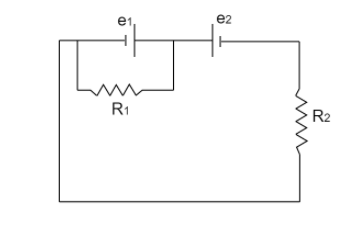Question
Question: In the circuit shown, \({{e}_{1}}={{e}_{2}}=2V\) and their internal resistances are \(0.5\Omega \) e...
In the circuit shown, e1=e2=2V and their internal resistances are 0.5Ω each. R1=0.5Ω and R2=1.5Ω . The current through R1 is

Solution
Hint Kirchoff’s current law states that the current entering a circuit junction will be the same as the current exiting a circuit junction. It can also be defined as the sum of the currents at a junction in a circuit is always zero, taking into account the direction of the current flow. Apply this law and Ohm’s law for the circuit given and proceed.
Complete Step by step answer
Let us assume that the current flow from the first cell to be I1 and the current flow from the second cell to be I2 . The currents from both cells will enter the junction and pass through the resistor from Kirchoff’s current law. Therefore, we can say that the current through the resistor R1 to be I1+I2 .
We can find the current through the first cell by using Ohm’s law.
e2=I2(R2+r2)
Here, r2 denotes the internal resistance of the second cell.
By substituting the given values of internal resistance of the second cell, the resistance of the second resistor, and potential due to the second cell, we get
2=I2(1.5+0.5)
⇒I2=22
⇒I2=1A
Applying ohm’s law to the first resistor, we get
e1=I1r1+(I1+I2)R1
Here, r1 denotes the internal resistance of the first cell.
By substituting the values of the potential of the first cell, the internal resistance of the first cell, the resistance of the first resistor, and by substituting the calculated value of the current I2 , we get
2=0.5I1+(I1+1)1.5
By simplification, we get
I1=0.25A
Therefore, the total current that passes through the first resistor R1 is given by
I1+I2=1+0.25
⇒I1+I2=1.25A
Hence, 1.25A is the total current that passes through the resistor R1 .
Note
The internal resistance of a cell is different from the load in a circuit. Usually, the internal resistances are even neglected as they are very small when compared to the load resistance. Internal resistance can be caused by either corrosion or due to sulfation.
